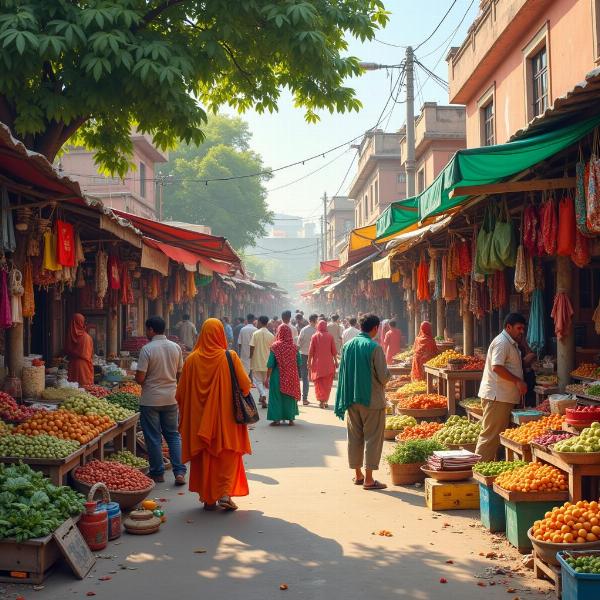Haats meaning in Hindi encompasses more than just a “market.” It represents a vibrant hub of rural Indian life, a social and economic cornerstone where commerce, culture, and community converge. Understanding the nuances of “haats” provides valuable insights into the dynamics of rural India. What does “haats” truly mean in Hindi, and what significance does it hold in the larger context of Indian culture and economy?
Exploring the Significance of Haats in Rural India
Haats are periodic markets, typically held once or twice a week, in designated open spaces within or near villages. They serve as vital trading centers for local farmers, artisans, and small-scale producers to sell their goods directly to consumers, often bypassing intermediaries. These markets offer a wide range of products, from agricultural produce and livestock to handicrafts, textiles, and household items.  Rural Indian Market Scene The haats system allows for price discovery based on local supply and demand dynamics, creating a more equitable marketplace for rural participants. The social aspect of haats is as important as the economic one. It’s a meeting place for people from surrounding villages to exchange news, build relationships, and participate in cultural activities.
Rural Indian Market Scene The haats system allows for price discovery based on local supply and demand dynamics, creating a more equitable marketplace for rural participants. The social aspect of haats is as important as the economic one. It’s a meeting place for people from surrounding villages to exchange news, build relationships, and participate in cultural activities.
The Etymology and Linguistic Roots of “Haats”
The word “haats” (हाट) in Hindi originates from the Sanskrit word “hatta” (हट्ट), meaning “market” or “marketplace.” Over time, the word has evolved and retained its core meaning, reflecting the enduring importance of these markets in Indian society. Regional variations and dialects may have slightly different pronunciations or related terms, but the core concept remains the same. For example, in some regions, they might be referred to as “mandi” or “bazaar,” which while similar, have distinct characteristics. The word “haats” itself carries connotations of a temporary, recurring market, distinguishing it from permanent shops or urban marketplaces.
Haats: More Than Just Markets
Haats are much more than just places to buy and sell. They function as critical social hubs, fostering community bonds and facilitating the exchange of information and ideas. Festivals, religious gatherings, and other cultural events often coincide with haats, adding another layer of social interaction and vibrancy to these events. The haats system also plays a significant role in supporting the livelihoods of marginalized communities, providing them with a platform to market their products and access essential goods and services. condiments meaning in hindi are often traded in haats, showcasing the diverse culinary landscape of India. salts meaning in hindi is another common commodity, highlighting the essential role of haats in providing everyday necessities.
How do Haats Contribute to the Rural Economy?
Haats provide a direct link between producers and consumers, minimizing the role of intermediaries and ensuring fairer prices. They boost local economies by facilitating the circulation of money within the community. This direct interaction fosters trust and transparency, crucial elements for a thriving rural economy.
What is the Social Impact of Haats?
Haats strengthen social cohesion by providing a regular platform for interaction. They serve as a venue for disseminating information, sharing news, and reinforcing cultural traditions. This strengthens the social fabric of rural communities.
Quote from Dr. Anita Sharma, Rural Economist: “Haats represent a crucial link in the rural economic chain, empowering local producers and preserving traditional trade practices.”
Quote from Mr. Rajesh Kumar, Social Anthropologist: “The social significance of haats is undeniable. They are spaces where communities come together, reaffirming their identity and fostering a sense of belonging.”
Conclusion: The Enduring Power of Haats
Understanding “haats meaning in hindi” requires acknowledging their multifaceted role in rural India. Beyond their economic function, haats are vital social spaces that support livelihoods, preserve cultural heritage, and strengthen community ties. These vibrant marketplaces continue to play a significant role in shaping the landscape of rural India.
FAQ:
- What is the frequency of haats? Haats are typically held once or twice a week.
- What kind of goods are sold in haats? Everything from agricultural produce and livestock to handicrafts, textiles, and household items.
- Where are haats located? Haats are located in designated open spaces within or near villages.
- Are haats only about economic transactions? No, haats also serve as important social hubs.
- What is the historical significance of haats? Haats have been a part of Indian culture for centuries, reflecting the importance of local trade and community interaction.
- What is the difference between haats and mandis? While both are markets, haats are generally smaller, more localized, and periodic, while mandis are often larger and more formalized, focusing on specific commodities.
- How do haats contribute to women’s empowerment? Haats provide women with opportunities to engage in economic activities, earn income, and gain social visibility.
salt meaning in hindi and meaning of rock salt in hindi might be of interest to our readers.
Meaning-Hindi.in specializes in accurate and culturally sensitive Hindi translations for various sectors, including business, legal, technical, and educational documents. Our expert team understands the nuances of the Hindi language and Indian culture, ensuring high-quality translations that meet your specific needs. We also offer website localization, transcription, and interpretation services. Contact us at [email protected] or +91 11-4502-7584. Meaning-Hindi.in is your trusted partner for all your Hindi language needs.